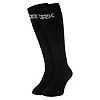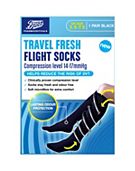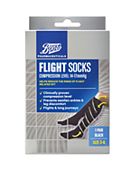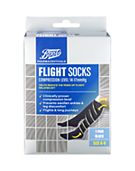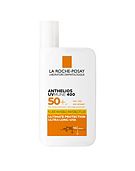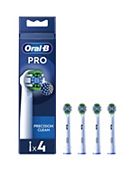CRX Compression Socks 3-6
In order to buy non-prescription medicines you must be a registered user of our site as we are obliged to record your transaction history. We also ask that you complete our questionnaire so our pharmacy team can check that this product is suitable for you to buy.
Disabled or chronically sick people can claim VAT relief on purchases for personal or domestic use that are applicable to their disability or sickness.
Stock coming soon
This product is temporarily unavailable online. Use ‘Find in store’ below to see if it’s in stock near you.
Check store stock overlay
 Product details
Product details
- Improves blood circulation
- Relieves pain and fatigue
- Promotes and supports vein health
- Reduces swelling in the legs and ankles
- Prevents blood clots in the legs
- Prevents and soothe venous ulcers, varicose veins, and spider veins
Blood Circulation
How Do Compression Socks Work?
The level of pressure they apply is measured in units called mmHg (millimetres of mercury). Most Over-the-counter compression socks will offer 14-17 mmHg (Level 1), but CRX socks offer 18-24 mmHg (Level 2), the level doctors prescribe.
Who Can Benefit From Compression Socks?
- People On The Go: Anyone who spends a significant portion of their day on their feet, standing or moving, can avoid swelling and fatigue and increase their comfort with compression socks.
- Travellers: Extended periods of inactivity while travelling by car, train or plane can compromise your circulation and increase your risk of developing DVT, or deep vein thrombosis. Research suggests that wearing compression socks during travel can reduce this risk and support your vein health.
- Athletes: Compression socks are increasingly sought after by athletes wishing to improve athletic performance and relieve post-workout discomfort and fatigue. Many athletes choose to use compression socks both during and after training and competition.
- Pregnant Women: Increased blood volume during pregnancy can put some women at increased risk for leg and ankle swelling, impaired circulation, and varicose veins. Compression socks can reduce this risk and can ease discomfort.
- People With Certain Medical Conditions: People who are at increased risk of blood clots in the legs, also known as deep vein thrombosis, due to family history, genetic disorders, surgery, injury, certain medications, or prolonged inactivity such as bed rest can benefit from the increased circulation promoted by compression socks. People with venous ulcers, and varicose and spider veins can find symptom relief and vein support with compression socks, especially while recovering from treatment.
Suitable for
Suitable for Adult
Children 16+
Hazards and Cautions
Contraindications in the medical world are situations in which something should not be prescribed or recommended. If you have any of the following, compression socks may not be right for you:
- Ischaemia: This is a lack of oxygen in the limbs due to peripheral arterial disease, particularly affecting your legs.
- Peripheral neuropathy: This is damage to the nerves in your hands, arms, feet and legs.
- Congestive heart failure: This arises when the heart muscle becomes weak or stiff and cannot pump blood around the body efficiently. It causes a build – up of fluid – oedema in the legs.
- Diabetes: Peripheral arterial disease and peripheral neuropathy are both complications of diabetes.
- Cellulitis: An infection deep within the skin that causes fluid build-up – oedema.
- Allergies: Some people can be allergic to components used to make compression garments. Skin reactions do occur – sometimes these can be solved by using a different brand or type, but if you are allergic to compression garments, wearing them will put you at risk of skin breaks and infection.
Important info
Manufactured in Portugal. Imported/Distributed by CRX Compression Ltd, Tudor House, 16 Cathedral Road, Cardiff, United Kingdom, CF11 9LJ
Ingredients
90% Polyamide 10% Elastane
Delivery options
Click & Collect
€2.50 or free if you spend €25 or more from your choice of 88 stores.
Exceptions apply for orders containing products with a green cross symbol. See Click & Collect for more details.
Standard Delivery
€5 or free when you spend €40 or more
For more information see our delivery help or view our returns policy.
Customers who viewed CRX Compression Socks 3-6 then bought
Buy 1 get 2nd 1/2 price …
€19.99
Buy 1 get 2nd 1/2 price …
€18.99
1 UNI|€18.99 per 1UNI
2 for €8.50 on selected …
€5.59
18 UNI|€0.31 per 1UNI
Customers who viewed this also liked
Buy 1 get 2nd 1/2 price …
€18.99
2 UNI|€9.50 per 1UNI
Buy 1 get 2nd 1/2 price …
€19.99
Buy 1 get 2nd 1/2 price …
€18.99
1 UNI|€18.99 per 1UNI
Bestselling health & pharmacy
Save 20 percent on selec…
€22.00
50 ML
Save up to 1/2 price on …
€20.99
4 UNI|€5.25 per 1UNI
3 for 2 on selected Vita…
€37.49
30 UNI|€1.25 per 1UNI
3 for 2 on selected Vita…
€5.49
90 UNI|€0.06 per 1UNI
